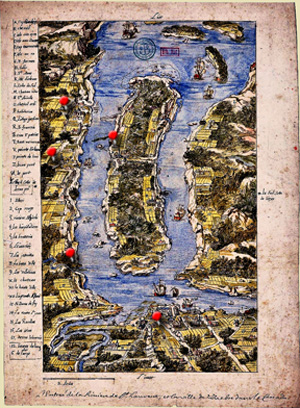L'île-d'Orléans.

Île-d'Orléans was an island located in the St-Lawrence River, just downriver from ville de Québec. The fertile land yielded important cereal crops like oats, wheat, and rice. The summer harvest included juicy, sweet fraises (strawberries) and framboises (raspberries). During the long cold winter months an icy road was carved across the frozen waterway to provide access to the mainland.
Nicolas and Marguerite received a concession on 2 February 1662 of 132 arpents at Charny-Lirec on the north side in the parish of Sainte-Famille, across from Beaupré and Château-Richer. (Another of our ancestors, Antoine Vermet, was living in Sainte-Famille at the time of his marriage to Barbe Menard in 1669.) Marguerite's donation of two pounds of butter to Saint-Anne du Petit Cap in Beaupré is noted in the church trustee account books in June 1665.
In the 1666 census of l'île-d'Orléans, Nicolas Patenostre, 40, stated he was a drapier (cloth merchant) and habitant. He and his 31 year wife, Marguerite Breton, had seven children: Pierre, 13; Jean, 11; Charles, 9 (our ancestor); Pierre, 7; Louis, 5; Marie, 3; Gervais, 18 months. A census taken the following year reveals another son, Nicolas, had been born. The family had 3 beasts (cattle or oxen) and 9 arpents of land under cultivation. He did not own a gun; if a defense had to be launched he joined the other men armed with an axe or pitchfork.
Nicolas passed away 13 February 1679 at the age of 50 and was buried two days later. Marguerite's record is lost, but it is known that the youngest of her children were cared for by their older sister Marie and her husband Claude Plante. On 7 March 1695 their inheritance rights were sold to their brother Marin.
- map by: Franquelin, Jean-Baptiste (1650-17..) at Bibliothèque nationale de France http://ark.bnf.fr/ark:/12148/cb41301166k
- Jetté, René, Dictionnaire généalogique des familles du Quebec des origines à 1730 (Montréal: Les Presses de l'Université de Montréal, 1983)
